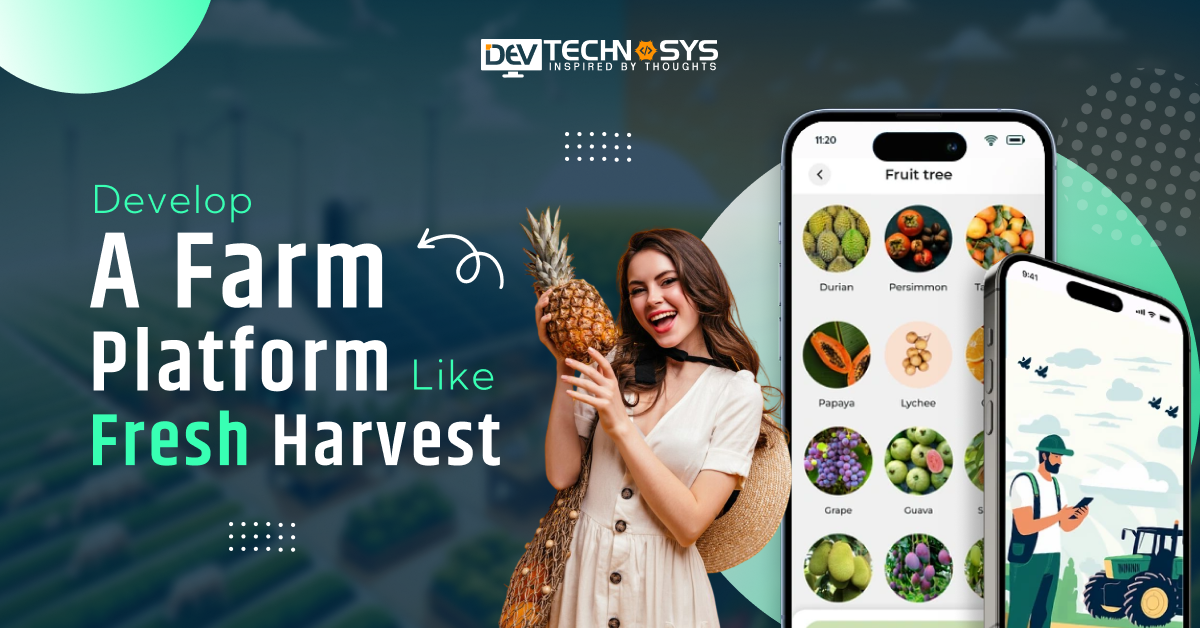Take vegetables and fruits directly from where they have their roots that is directly from the farms. But it is not easy for the people of cities because they do not have such fields where vegetables and fruits grow.
People do not go anywhere; there is an incredible platform like Fresh Harvest that allows users to purchase fresh vegetables, fruits, and dairy products. This platform allows users or consumers to receive the delivery of their products at their specific location, and they can also schedule a pickup.
As per the recorded survey, the farm management platforms were valued at around $3.30 billion in 2022. It is projected to grow around $10.27 billion by the end of 2032, with a CAGR of 16.2% during the forecast period.
By showing this amazing growing data, most businesses or entrepreneurs want to create a farm platform like Fresh Harvest.
In this blog, we will explore detailed information about how to develop a farm platform like Fresh Harvest and various cost-affecting factors.
What Is Fresh Harvest?
Fresh Harvest is a platform that delivers fresh, locally produced produce and goods straight to consumers’ doorsteps. It connects consumers with farmers and food producers, providing a wide range of fresh fruits, vegetables, dairy products, and pantry essentials.
The program focuses on supporting local agriculture and promoting healthy eating. If you want to develop an agritech mobile app, then you can consult with the best mobile app development company to offer reliable solutions.
- Fresh Harvest connects clients with local farmers by offering fresh.
- Customers can customize their orders to meet dietary needs by selecting specific goods.
- Fresh Harvest provides various subscription programs for frequent deliveries.
Market Analysis of Farm Platforms
- According to the global market, the farm management platforms were valued at around $3.30 billion in 2022. It is projected to grow around $10.27 billion by the end of
- As per the recent survey, the farm management platforms are expected to grow with a compound annual growth rate of 2% from 2024 to 2032.
- According to a study, North America is one of the most revenue-generating countries in farm management platforms from 2023 to 2024.
- In deep research, the number of downloads will rapidly increase in 2024, and it is expected to increase by the end of 2028.
- In farm management platforms, cloud computing plays a vital role in the farming platforms and access to real-time updates.
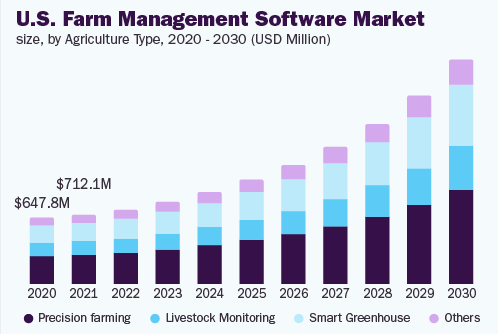
10 Best Farm Platforms Like Fresh Harvest
Here are best Agtech apps like Fresh Harvest, with download numbers, ratings, launch years, and platform availability:
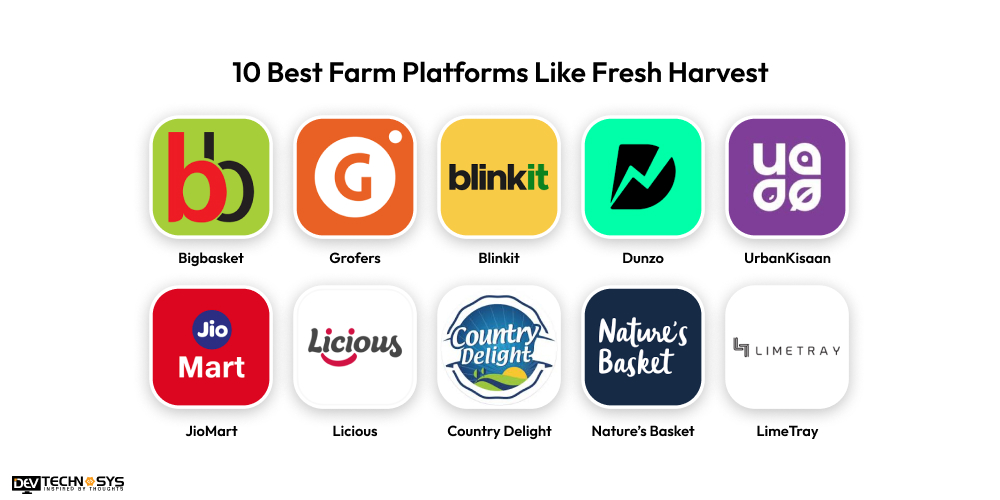
| Apps | Download Users | Stores Ratings | Apps Launched On | Platform Accessibility |
| Bigbasket | 10M+ | 4.7 | 2011 | Android/iOS |
| Grofers | 10M+ | 4.2 | 2013 | Android/iOS |
| Blinkit | 10M+ | 4.2 | 2013 | Android/iOS |
| Dunzo | 10M+ | 4.5 | 2015 | Android/iOS |
| UrbanKisaan | 1M+ | 4.2 | 2023 | Android |
| JioMart | 10M+ | 4.4 | 2020 | Android/iOS |
| Licious | 1M+ | 4.3 | 2015 | Android/iOS |
| Country Delight | 1M+ | 4.6 | 2015 | Android/iOS |
| Nature’s Basket | 500K+ | 4.2 | 2016 | Android/iOS |
| LimeTray | 500K+ | 4.4 | 2017 | Android/iOS |
Why Most Entrepreneurs Invest in Farm Platform Like Fresh Harvest?
Entrepreneurs are investing in farm platforms because they align with consumer demand, have the potential for scalability, support local economies, and are technologically efficient and sustainable.
These features, combined, make such platforms an appealing business opportunity. Entrepreneurs are increasingly investing in Fresh Harvest platform development for several strategic reasons:
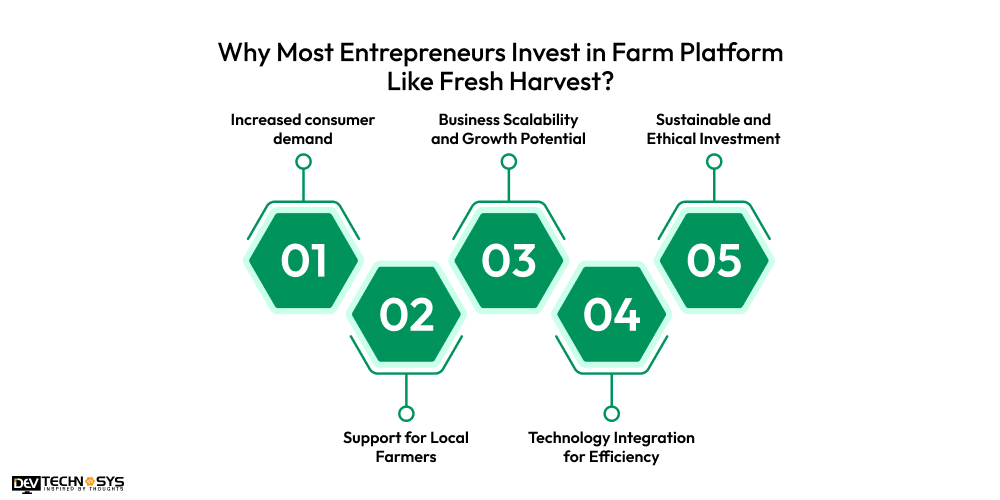
1. Increased consumer demand
Consumers are increasingly adopting healthier eating habits, with many preferring fresh, organic, and locally sourced foods. As people become more cognizant of where their food originates from, the demand for farm-to-table delivery services grows. Fresh Harvest and other such sites address this demand by providing direct access to farm-fresh produce.
2. Support for Local Farmers
Investing in farm platforms allows you to support local agriculture by connecting farmers to a larger consumer base. Small and medium-sized farms sometimes struggle with direct access to large markets, and these platforms provide a means for farmers to sell their products directly to customers.
3. Business Scalability and Growth Potential
Farm delivery platforms, such as Fresh Harvest, offer enormous expansion potential. With the growing popularity of e-commerce and online services, particularly in the aftermath of the pandemic, the ease of having goods delivered directly to one’s home is a major lure.
As we discussed earlier with a custom website development company, entrepreneurs see farm platforms as scalable business models that can grow regionally, nationally, or even internationally.
4. Technology Integration for Efficiency
Farm-to-consumer systems use technology to streamline operations including ordering, delivery, and inventory management. For entrepreneurs, investing in these platforms entails being a part of a tech-driven company that increases productivity.
Real-time tracking, personalized ordering, and automated deliveries increase customer experience and operational productivity, making these platforms a good investment.
5. Sustainable and Ethical Investment
Sustainability is an increasing concern, and many entrepreneurs are drawn to investments that support ethical and environmentally responsible operations. Farm platforms such as Fresh Harvest frequently focus on decreasing food waste, using environmentally friendly packaging, and promoting sustainable agriculture.
7 Major Steps to Develop a Farm Platform Like Fresh Harvest
Developing a farm platform like Fresh Harvest involves several key steps. By doing these actions, you can create a farm platform that is successful, like Fresh Harvest, supports local farmers and caters to consumer demands while preserving a seamless and pleasurable user experience. Here we provide the robust mobile app development process:
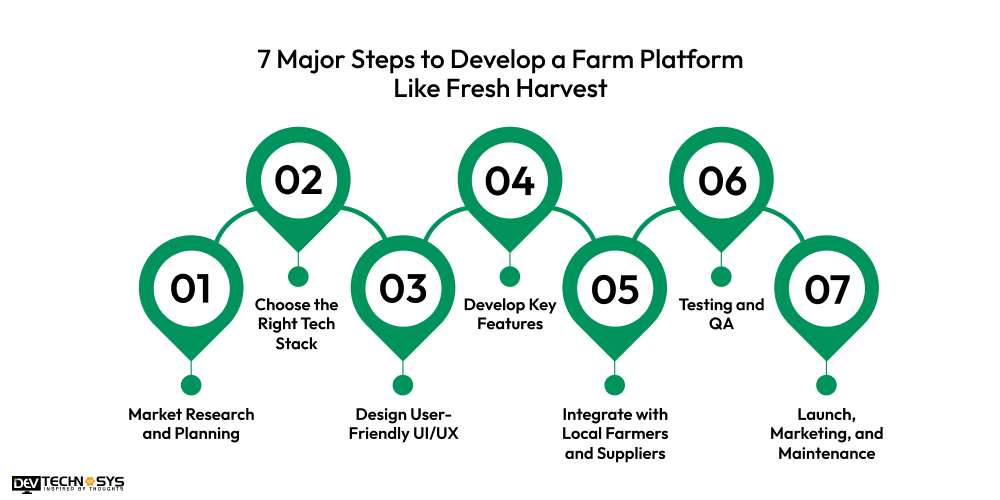
1. Market Research and Planning
Before you start developing your platform, it’s important to understand your target market. Research your potential customers, their needs, and the competition in the farm-to-consumer space. Identify the types of produce or products you want to offer, such as organic vegetables, fruits, dairy, or specialty items.
| What are your app’s basic requirements and future goals? |
| Make an organized sheet of the project’s actual needs |
| Which farm platforms are more trending in this competitive market? |
2. Choose the Right Tech Stack
The next step is to decide on the technology you’ll use to build your platform. Choose the right tools and technologies for both the front end (user-interface) and back end (server-side processes).
HTML, CSS, and JavaScript for the front-end designing, and Python and Java for the back-end operation. So, hire dedicated developers to choose the best tech stacks according to your overall budget.
| Which type of tech stacks are used in your Fresh Harvest app development? |
| Define your tech stack requirements. |
| Choose advanced or core tech stacks. |
3. Design User-Friendly UI/UX
The design of the platform is crucial for user engagement. A user-friendly design will make it easy for customers to navigate and place orders. Work with a UI/UX designer to create a responsive and attractive website or app.
Focus on making the user journey simple—from browsing produce to completing checkout. Prioritize features like easy navigation, search filters, and a smooth checkout process to enhance the user experience.
| What are wireframes in UX design? |
| What tools do you use for prototyping? |
| How do you ensure a responsive design? |
4. Develop Key Features
Move to the fourth stage of development, and select the best features and functions that you want to integrate into your farm platform. Hire experienced developers from a custom software development company to integrate advanced functionalities such as payment gateway integration, order management, account management, real-time tracking, and more.
| What are your project’s basic features and functions? |
| Observe the key features of popular farming platforms. |
| Make a clear sheet of features and functions. |
5. Integrate with Local Farmers and Suppliers
To offer fresh, local produce, establish partnerships with local farmers and suppliers. Develop a system to manage inventory, product listings, and supplier payments. This integration allows you to offer a wide variety of fresh, seasonal items while supporting local agriculture.
| How do you establish partnerships with local farmers? |
| How do you handle payment processing for local farmers? |
| Develop third-party integrations to list the supplier’s items |
6. Testing and Quality Assurance
Before launching your platform, test it to ensure everything works as expected. This includes functional testing (ensuring all features work), security testing (protecting user data and payments), and performance testing (making sure the platform handles traffic smoothly).
Hire the best agriculture technology solution companies to conduct both manual and automated testing to identify and fix any bugs or issues.
| Make sure that all features and functions are working properly |
| How do you test an app on different devices? |
| Identify bugs and glitches during the app testing |
7. Launch, Marketing, and Maintenance
Once your platform is ready, launch it to your target audience. Promote the platform through social media, digital ads, and influencer partnerships to attract users. After the launch, regularly update the platform with new features, products, and improvements.
Ongoing maintenance is necessary to fix bugs, update security features, and keep the platform running smoothly.
| Publish your app on selected platforms like Android and iOS. |
| Make sure that all features and functions are successfully implemented |
| Now the app is available for the users on the app stores. |
10 Must-Have Features of Farm Platforms Like Fresh Harvest
A farm platform such as Fresh Harvest must include crucial features to assure customer satisfaction, streamline operations, and remain competitive. Here are the ten must-have features:
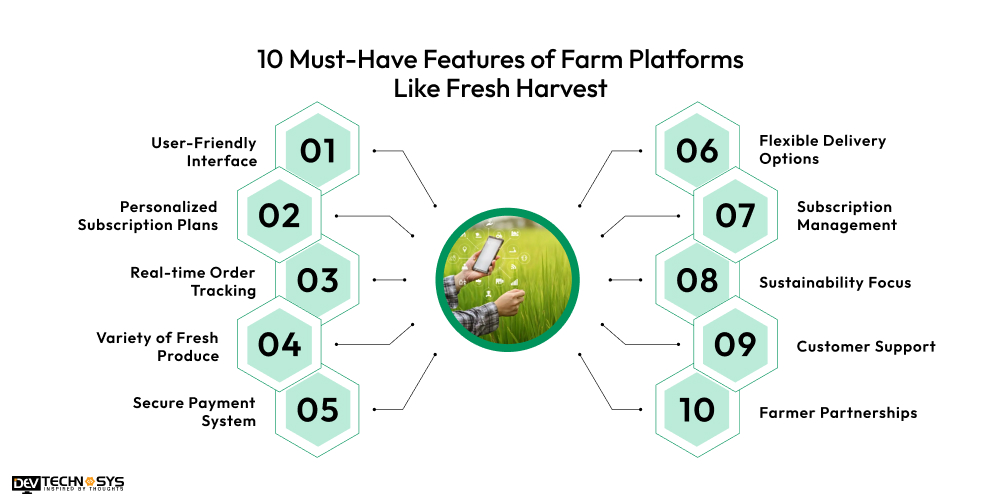
1. User-Friendly Interface
Customers may swiftly browse and order products on a mobile app or website thanks to a clean, intuitive design that allows for easy navigation.
2. Personalized Subscription Plans
Fresh Harvest alternatives offering customizable subscription options based on delivery frequency, chosen items, and portion sizes allow you to cater to individual tastes.
3. Real-time Order Tracking
Customers should be able to track their orders in real-time, allowing them to monitor and control the delivery process.
4. Variety of Fresh Produce
A comprehensive range of seasonal and locally sourced fruits, vegetables, dairy, and other grocery goods should be accessible to accommodate a variety of dietary demands.
5. Secure Payment System.
The Fresh Harvest clones integrating secure payment gateways to provide a smooth and safe transaction procedure is critical for user trust.
6. Flexible Delivery Options
Customers benefit from having many delivery options and methods, such as same-day or planned deliveries.
7. Subscription Management
Fresh Harvest alternatives allow clients to effortlessly suspend, amend, or cancel their subscriptions to meet changing needs or preferences.
8. Sustainability Focus
Consumers who care about the environment value eco-friendly packaging, sustainable sourcing, and waste reduction initiatives.
9. Customer Support
The Fresh Harvest clones offer 24/7 customer service via chat or phone, is critical for resolving concerns such as delivery delays, order anomalies, and product inquiries.
10. Farmer Partnerships
Building solid partnerships with local farmers guarantees that the platform delivers fresh, high-quality produce while also benefiting the agricultural community.
The Cost To Build a Farm Platform Like Fresh Harvest
The cost to develop a community farm platform such as Fresh Harvest varies greatly depending on features, complexity, and platform (web, mobile app, or both). On average, creating a simple farm-to-consumer platform with fundamental functionality (e-commerce, subscription management, payment gateways, and delivery tracking) can cost between $8,000 and $20,000.
More advanced capabilities, such as AI-based suggestions, real-time tracking, cross-platform connectivity, and strong customer support systems, might raise the price to $25,000 or higher.
| Farm Platform Development | Estimated Cost | Time Frame |
| Basic Platform Development | $8000 – $12000 | 2 to 4 Months |
| Mid-Premium Platform Development | $13000 – $22000 | 5 to 8 Months |
| High-Premium Platform Development | $25000+ | 9+ Months |
What Are The Major Factors That Affect Fresh Harvest Clone Platform Development Costs?
The total cost of constructing a Fresh Harvest clone platform is greatly influenced by a number of factors. Below is a summary of the essential components:
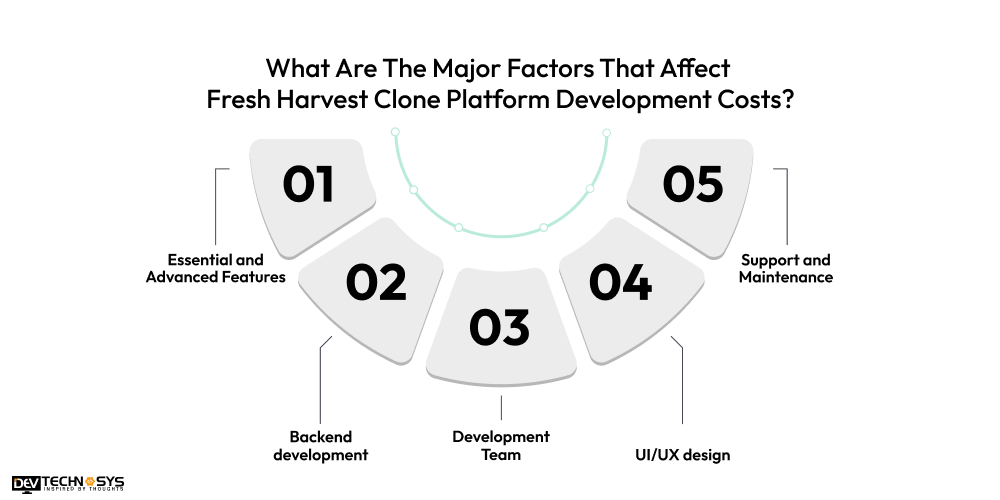
1. Essential and Advanced Features
It is less expensive to integrate basic functionality like a payment gateway, user registration, and a product catalog. Because they demand additional development time and resources, premium features like AI-driven suggestions, real-time delivery tracking, advanced analytics, or multi-language support raise expenses.
| Features | Cost Estimation |
| Core Features(Real-time tracking and order history) | $8,000 – $12,000 |
| Advanced Features(Secure payment methods and higher security protocols) | $15,000 – $20,000 |
2. Backend development
The platform’s backend, which handles user information, orders, inventory, and payment processing, is its central component. Development expenses can be greatly increased by the backend’s complexity, which includes integrating secure payment methods, handling big databases, and real-time order tracking. Efficiency, security, and scalability all depend on a robust backend.
| Backend Development | Cost Estimation |
| Basic Backend Process | $10,000 – $18,000 |
| Premium Backend Process | $20,000 – $28,000 |
3. Development Team
Costs are influenced by the AgTech software development team’s size and level of experience. UI/UX designers, quality testers, and frontend and backend developers are common members of a team.
Pricing is also influenced by the team’s location; teams in North America or Europe, for example, may be more expensive than those in Asia. The cost is also increased by skilled developers and experts.
| Developer’s Location | Cost Estimation |
| Asia Pacific | $8,000 – $15,000 |
| North America | $15,000 – $20,000 |
| Eastern Europe | $13,000 – $18,000 |
| Western Europe | $16,000 – $25,000 |
4. UI/UX design
A smooth and easy-to-use UI/UX design is essential to a satisfying user experience. Given the wide range of users, the platform needs to be simple to use, particularly on mobile devices. Advanced features like animations or interactive elements in custom designs might raise the cost of the design.
| Design Quality | Cost Estimation |
| Basic Design | $8,000 – $12,000 |
| Complex Design | $15,000 – $22,000 |
5. Support and Maintenance
Post-launch maintenance is essential for server maintenance, bug fixes, and updates. The mobile app maintenance service costs around 10%–20% of the original development expenditures per year, including security enhancements, software upgrades, and customer support.
| Maintenance Phase | Cost Estimation |
| Simple Maintenance Phase | $2,000 – $4,000/year |
| Complex Maintenance Phase | $8,000 – $10,000/year |
5 Monetization Techniques of Community Farm Platform Like Fresh Harvest
Fresh Harvest and other farm platforms can use a variety of monetization strategies to make money while providing consumers with locally grown, premium produce. By using these monetization techniques, farm platforms can increase the variety of their revenue streams while maintaining their sustainability and profitability. Here are five efficient techniques:
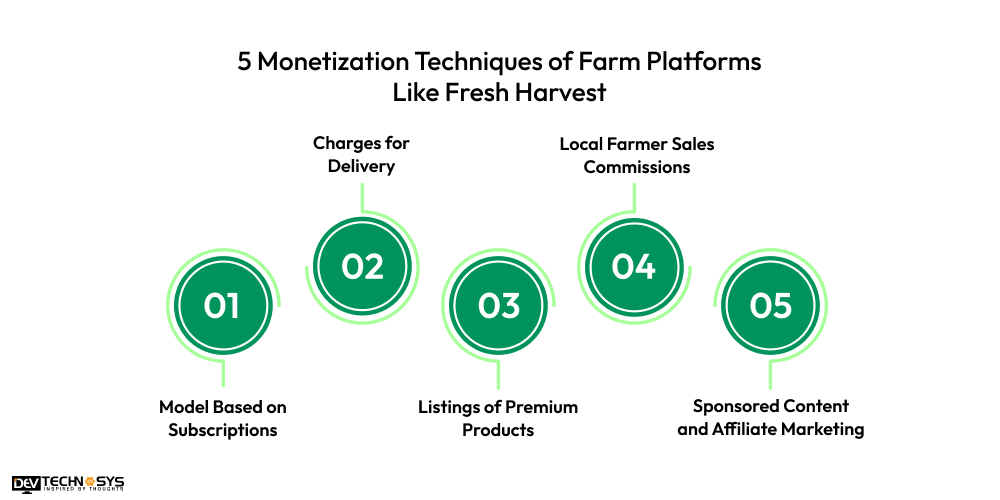
1. Model Based on Subscriptions
A subscription-based business is among the most often used monetization strategies. Weekly, biweekly, or monthly fresh produce deliveries are paid for by customers. This strategy guarantees client retention and gives the platform steady, recurring revenue. Seasonal vegetables, curated boxes, or personalized orders are all possible for subscribers.
2. Charges for Delivery
Customers frequently pay a delivery fee on farm platforms, which might change according on the order amount, time slot, and delivery distance. For example, ordinary deliveries may be provided at a standard charge, but same-day or expedited delivery may be more expensive.
In order to entice users to spend more money, several sites additionally provide free delivery on orders exceeding a specific amount.
3. Listings of Premium Products
Premium or specialized products, such as organic, unusual, or difficult-to-find items, might be featured on farm platforms. Because these premium listings are frequently more expensive, the platform has the chance to make more money with every transaction.
Offering gourmet fruits, handcrafted goods, or environmentally responsible products in upscale packaging, for instance, can draw in clients looking for one-of-a-kind or superior products.
4. Local Farmer Sales Commissions
To sell their goods directly on the platform, numerous farm platforms collaborate with nearby farmers and food producers. Every sale generates a commission for the platform, which may be a fixed percentage or a one-time charge.
According to the mobile app development company, this partnership approach enables the platform to generate revenue without keeping inventory.
5. Sponsored Content and Affiliate Marketing
Farm platforms can incorporate affiliate marketing by endorsing things from other parties, such as kitchenware, health supplements, and culinary tools. Platforms receive a percentage on purchases generated by these recommendations through sponsored content or affiliate links.
Ads from companies or goods that share the platform’s ideals can also be included in sponsored content, which brings in extra money.
Conclusion
There is a great chance to link local farmers with consumers looking for sustainable, fresh produce by creating a farm platform similar to Fresh Harvest. You can develop a platform that not only satisfies rising customer demand but also promotes your businesses and gives you a chance to reach new heights of success. It includes various advanced features such as streamlined order processing, a secure payment gateway, real-time tracking, and push notifications.
Do you want to make a farm platform like Fresh Harvest? Then you can consult with our AgTech software development company to provide futuristic development solutions.
Frequently Asked Questions
Q1. How Much Does It Cost To Develop a Farm Platform Like Fresh Harvest?
Depending on features, complexity, design, technology stack, and development time, the community farm platform development cost ranges from $8,000 to $25,000.
Q2. How Much Time Does It Take To Build a Farm Platform Like Fresh Harvest?
It usually takes 4 to 9 months to develop a farm platform like Fresh Harvest, depending on the features, testing, design complexity, scope, and productivity of the development team.
Q3. Why Do Most Businesses Invest in Similar Platform Like Fresh Harvest?
To improve sustainability and profitability, businesses spend money on platforms like Fresh Harvest:
- Increase efficiency
- Reach a wider market
- Give customers fresh items
- Locally produced items
- Competitive Advantage
Q4. Which Technologies Are Used To Create a Farm Platform Like Fresh Harvest?
Various advanced technologies are used to make a farm platform like Fresh Harvest:
- Java
- Python
- PHP
- React Native
- Flutter
